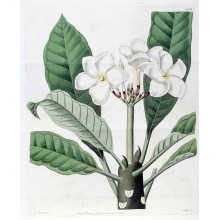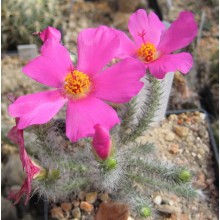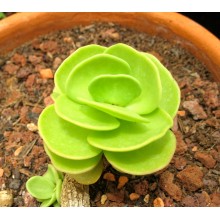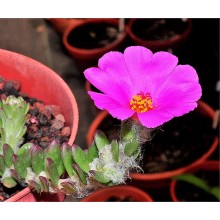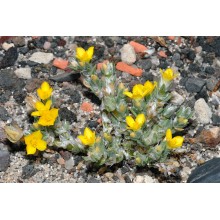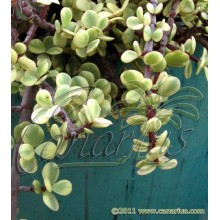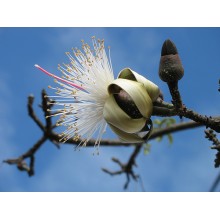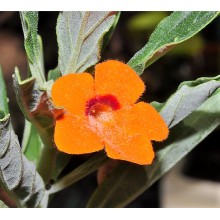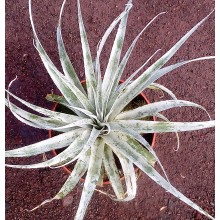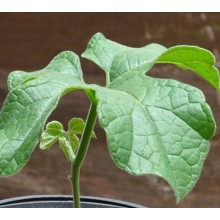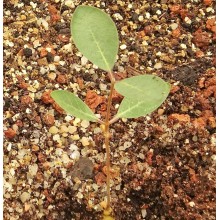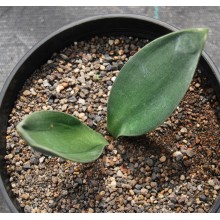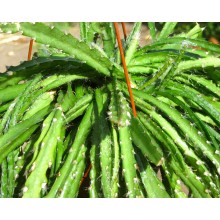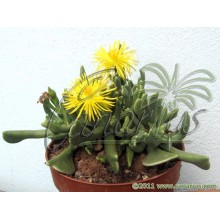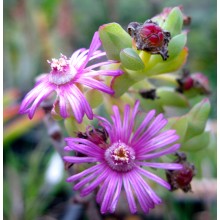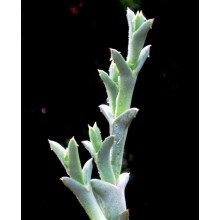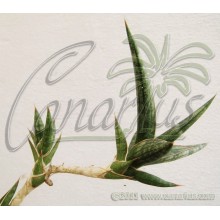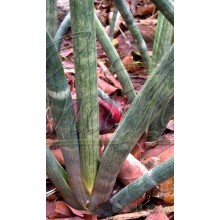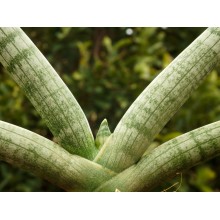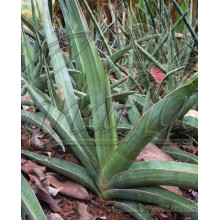Succulente Ci sono 628 prodotti.

I deserti del mondo e le zone secche ospitano le piante più interessanti. Canarius offre una selezione crescente di piante succulente di massima qualità, perché sono coltivate all'aperto, in pieno sole delle Isole Canarie.
I succulente o "piante grasse" sono specie di ritenzione di acqua, adattate alle condizioni di asciutto. Loro accumulano succum (succo, acqua) nelle loro foglie, steli o radici, e spesso mostrano un aspetto robusto e carnoso.
Sotto-categorie
-
Agave
Agave è un genere di piante grasse provenienti dall'America. Alcune specie crescono in zone fredde e possono sopportare un forte gelo, mentre altri vivono in climi tropicali. Alcuni sono piccoli nani e alcuni sono giganti, fino a 2 o 3 m di larghezza.
Le agavi resistenti al freddo possono creare un effetto esotico nel vostro giardino. Le specie agave fanno bella compagna di palme o cactus. Le agavi variegate sono incredibilmente ricercati dai collezionisti. Il nostro negozio web offre una selezione in continua evoluzione delle specie. Spediamo piante a radice nuda, se non diversamente specificato.
-
Aloe, Gasteria & Haworthia
Aloe, Gasteria e Haworthia sono tre generi correlate, comprese centinaia di piante succulente. Sono tutti facilmente coltivate in vaso. Alcuni si adattano a bassi livelli di luce di condizioni interne e possono essere coltivate come piante da appartamento.
- Aloe è un genere di circa 400 specie, originarie di Africa, Arabia e Madagascar. I aloe piccoli o nani stanno diventando particolarmente popolare in climi più freddi in quanto possono essere presi in casa durante i mesi più duri.
- Gasteria comprende circa 80 specie endemiche in Sud Africa, conosciuti per le loro foglie spettacolari che sono lucide, screziati e ruvidi. Fioriscono in primavera-estate con lunghe punte di piccoli fiori arancioni. Alcune specie sono talmente variabile che offriamo cloni particolari di località specifiche.
- Haworthia è un genere endemico in Sud Africa con circa 70 specie e un certo numero di sottospecie locali, varietà e forme. Le foglie sono spesso banded, punteggiati, punteggiato, o semi-trasparente e mostrano ampie variazioni.
-
Crassule
Questa è una nuova e crescente sezione di specie della famiglia Crassulaceae. Ci sono circa 1.400 specie in 33 generi et la loro distribuzione è in tutto il mondo, ma si presentano più nell'emisfero Nord e Sud Africa, in particolare in ambienti asciutti. Qui si possono acquistare piante sani, indurito dal sole, coltivati nelle isole Canarie e spediti a casa tua.
-
Mesembriantemi
Questo gruppo di piante del deserto è chiamato Mesembriantemi perché appartengono a una famiglia botanica precedentemente denominata Mesembryanthemaceae. Ci sono quasi 2.000 specie, che si trovano principalmente in Africa del sud, con adattamenti estremi agli habitat secco. Alcuni sono chiamati "pietre vive", perché sembrano come ciottoli. Molti sono facili da coltivare e il loro bisogno principale è pieno sole. Alcuni sono difficili perché crescono nelle aree veramente estreme.
Il nostro Web Shop offriamo piante sane coltivate al sole, con foglie compatte e colorate. Alcune piante sono venduti come talee, e altri come piante radicate, di almeno due anni. -
Sansevieria
Recentemente assegnato alla famiglia Asparagaceae, il genere Sansevieria conta circa 70 specie, quasi tutti nativi in Africa, Arabia e Madagascar. Erbe perenni adatti per gli habitat secchi con foglie rigide, succulente, la loro lunghezza varia da pochi centimetri a 2 metri. Sansevieria trifasciata e le sue numerose cultivar sono tra le piante d'appartamento più apprezzati, popolarmente chiamata la lingua di suocera. Una pianta ben coltivata di solito produce un picco di molti fiori bianchi, riccamente profumati e poi bacche arancioni. Anche le specie più rare sono resistenti ad abbandono, a condizione di tenerli dal gelo in inverno e sole cocente in estate.
-
Hoya
Le Hoyas sono rampicanti, dai fiori esotici e spesso vistosi. Provengono dalle foreste pluviali in Asia e Oceania. La maggior parte delle specie vive bene a mezz' ombra e si adatanno a vivere in casa come piante da appartamento. Sono ideali per cesti e tralicci. Tollerano un paio di settimane di siccità, ma sono sensibili al gelo e freddo. Molte hoya i sono facili da far crescere e fiorire, mentre alcune sono difficili e rare.
-
Asclepiadaceae
Le Asclepiade, o Asclepiadoideae, sono una sottofamiglia delle Apocynaceae, che annoverano circa 2900 specie diverse. Tra queste si trovano molti fusti privi di foglie ma anche erbe perenni, arbsuti, liane e, raramente, alberi. Producono fiori molto belli, dato il complesso sistema di impollinazione. Molte specie producono un odore insolito, spesso associato a quello di una carogna, la cui funzione è quella di attrarre le mosche che poi andranno a impollinare i fiori. -
Caudiciformi
Queste piante, dette anche pachicauli, sono tipiche delle zone aride. Producono un tronco insolitamente grosso e sproporzionato, detto caudice (a volte anche tubero), spesso con ramificazioni. Il caudice può essere anche nascosto sottoterra, ma nella maggior parte dei casi ha sviluppo verso l'alto, dando luogo ad alberi dalla forma spettacolare. I caudiciformi più grandi sono i baobab. -
Altre succulente
Qui troverete tutte quelle specie di piante del deserto che non sono inclusi nella propria categoria. Metteremo qui tutte le piante provenienti da famiglie inusuali, diversi da Agavi, Aloe, Crassulaceae, Sansevieria, Mesembriantemi, Epiphytic cacti, etc.
-
Plumeria rubra - Wild Type
Plumeria rubra - Wild Type
This is a wild form of Plumeria rubra, not a hybrid or a selection as ALL the ones you will find in the trade. Wild types are tough guys from the coastal scrubs of Central America, able to withstand truly harsh conditions. It is very vigorous with large leaves. Flowers are white with a yellow center.
42,00 € -
Portulaca eruca
Portulaca eruca
Beautiful shrublet, all coated in white hairs. It blooms easily and the pink flowers look comparatively enormous!
16,50 € -
Portulaca molokiniensis
Portulaca molokiniensis
1-2 year old seedling. The Hawaiian archipelago is known for its lush tropical vegetation and few succulents occur in the native flora. This portulaca is a hard-to-find gem, admired by collectors for its compact, symmetrical habit. Well grown plants are truly beautiful and bear yellow flower heads. This endangered species only occurs on a few islets.
24,50 € -
Portulaca werdermannii
Portulaca werdermannii
Cute portulaca species, branched, with very hairy leaves and showy purple flowers. It blooms profusely through the warmer months of the year.
20,50 € -
Portulaca wightiana
Portulaca wightiana
Tuberous" Portulaca with a thick caudex taproot, with stems bushily branched, articulated, up to 7 cm high It blooms profusely with yellow flowers and this miniature makes a very ornamental effect.
16,30 € -
Portulacaria afra variegata
Portulacaria afra variegata
Cont.= 8,5 cm. Variegated selection of the popular succulent shrub with small round leaves. This cultivar has a beautiful cream and green variegation. The stems are reddish brown. It is very easy to grow, but slow.
10,40 € -
Pseudobombax ellipticum "white flower"
Pseudobombax ellipticum "white flower"
.We offer plants of 3 cm caudex.
31,60 € -
Puya harmsii- Large
Puya harmsii- Large
Beautiful large Puya with grey-white leaves with few spines, up to 1 m tall, forming clusters with age It bears showy inflorescences, 2 m tall, with blue-black flowers from purple-pink bracts. It is known from a few restricted location at high altitude in the provinces of Tucuman and Catamarca, in northwestern Argentina.
51,30 € -
Pyrenacantha kaurabasana
Pyrenacantha kaurabasana
Very ornamental caudex-forming shrub from Southern Madagascar. It is an easy species and it is rather fast growing and free-blooming when grown in hot coastal weather.
31,00 € -
Raphionacme lanceolata
Raphionacme lanceolata
Caudex-forming asclepiad with scrambling stems. It builds a sub-spherical caudex, up to 35 cm in diameter. The velvety stems grow up to 50 cm long and spread horizontally. Leaves are also more or less densely velvety on both surfaces
26,00 € -
Rauhia multiflora
Rauhia multiflora
South american xerophytic bulb, with large, remarkable succulent leaves. The bulb is coated by papery brown sheaths and holds 1-4 leaves, but most often a pair of two. These are beautifully channeled, ovate-rounded, tongue-like. held on wide petioles.
12,30 € -
Rhombophyllum rhomboideum
Rhombophyllum rhomboideum
NEW! - Branched plant, Cont.= 8,5 cm. Grows in open limestone gravely patches in the subtropical thicket vegetation areas around Port Elizabeth and Uitenhage in So.Africa. The area has mild coastal temperatures and both summer and winter rainfall.
10,30 € -
Ruschia maxima
Ruschia maxima
NEW! - Two 20 cm cuttings. Ornamental succulent shrub,30-100 cm tall, with simmetrical blue leaves with a pink tinge andbright pink flowers. It is widespread in South Africa and standsfrosts, fires and drought. It does well
10,80 € -
Sansevieria ballyi 12681
Sansevieria ballyi 12681
One mature rosette, 5-8 cm diameter. A miniature creeping Sansevieria, with spiky tight rosettes on stolons. This "Bally 12681" from Kenya is surely the smallest and the cutest of all the species! Easy and fast growing. Good for terrariums and for hanging baskets.
17,20 € -
Sansevieria cylindrica Banded Leaves
Sansevieria cylindrica Banded Leaves
NEW ! Large head with leaves of 30-40 cm - This species has cylindrical smooth leaves with a green-gray banding.Old plants in the ground can reach 1-2 m in height.
6,95 € 13,90 €Prezzi ridotti! -
Sansevieria cylindrica var. patula
Sansevieria cylindrica var. patula
Patula is the most compact variety of the popular Sansevieria cylindrica. Leaves are cute and chubby, silvery and banded in high light. Solitary plants often resemble a chubby human hand !
18,30 € -
Sansevieria ehrenbergii
Sansevieria ehrenbergii
30-40 cm wide. This is a form with green long leaves, originating from Ethiopia or Eritrea. There are some similar plants in Somalia with shorter grayer leaves. Fan-shaped succulent with distichously arrangedthick leaves, of a bright blue-green. Slow growing and still very uncommon in the trade.
9,25 € 18,50 €Prezzi ridotti!
Al momento ci sono pochi prodotti in questa categoria Succulente

























